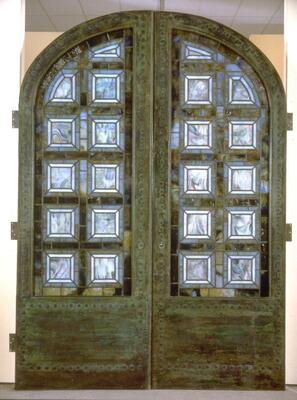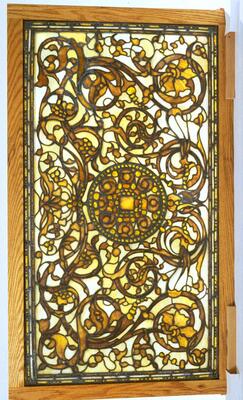The Havemeyer House
The time between the late nineteenth and early twentieth centuries was an exciting period for the visual arts with the birth of modernism in Europe and the institution of the Aesthetic Movement in the United States. Louis Comfort Tiffany (1848 – 1933) was an American decorative artist whose work made a huge impact on the visual arts. Trained as a painter, he distinguished himself from many other American artists in his use of light as a design element of equal importance to color. His work is remembered today as innovative, unique, and, above all, beautiful.
Tiffany worked primarily in New York, which was growing rapidly at that time. The city came alive toward the end of the nineteenth century, with the upper class migrating uptown above 42nd Street, creating a cluster of wealth in the Upper East Side (see map). For wealthy families, such as the Vanderbilts and the Rockefellers, who made their fortunes in railroad and oil empires, art collecting was extremely popular and many private residences, like the Havemeyer House, included world-class private collections.
H. O. Havemeyer: The “Sugar King”
Henry Osborne Havemeyer was born in New York in 1847. He inherited a family business in sugar refining, which generated an immense fortune. In 1868 he was made a partner in the Havemeyer and Elder firm, a position that enabled him to gain a great deal of influence in trade. He founded the American Sugar Refining Company in 1891 and acquired about half of the Spreckels Sugar Company stock, which indirectly led to his control of most of the sugar business to the west of the Mississippi River. Called the “Sugar King” in reverence by some and criticism by others, Havemeyer is noted for having used questionable business tactics to acquire his fortune.
In 1883, Havemeyer married Louisine Elder, the niece of his first wife, Mary Louise Elder. Together, the couple would acquire thousands of art objects ranging from Tiffany glassworks to canvasses by El Greco and an extensive Impressionist collection. Louisine had spent time in Paris, where she was very close to the American painter Mary Cassatt. Cassatt encouraged her to purchase works by the then underappreciated Impressionists. Louisine’s aesthetic leaned toward western art, while Henry was more inclined toward eastern pieces. Their combined tastes blended both worlds.
By 1888, the Havemeyer collection began to outgrow the family’s 36th street home in downtown New York. The fashionable place to move at the time was uptown on Madison and Fifth Avenues, so in 1889 they purchased property on Fifth Avenue at 66th Street, on which a house was to be designed by architect Charles Coolidge Haight and decorated by artists Louis Comfort Tiffany and Samuel Colman. The construction and decoration of the house would take place between 1889 and 1891 and the end result was nothing less than spectacular.
The Havemeyer House
Built in Romanesque Revival style, 1 which was quite popular at the time, the Havemeyer home on Fifth Avenue and 66th Street featured “a large round turreted bay that bulged out at the Fifth Avenue corner, and the round-arched openings of the three ground-floor windows at the door.” 2 While the outside of the building remained relatively unadorned and somber, its interior glittered and sparkled. Despite the house’s initial purpose – to house the Havemeyer art collection – the building was in and of itself a work of art.
As a member of the Aesthetic movement, which preached “art for art’s sake,” Tiffany was interested in making the world around him beautiful. He is closely associated with art nouveau, which merged Eastern and Western styles. He worked primarily in glass, and was infatuated by the way light played off of his creations. Like the Impressionists, he used light as a design element, making it almost as important as color, and his use of glass, metal, woodwork, and natural elements created a space for the Havemeyers that was set apart from the ordinary world.
The entrance hall was a spectacular area of the home that set the mood for the rest of the building. As Alice Frelinghuysen points out, “The hall was one of the most important rooms of any Victorian home. This area had a public, almost ceremonial function and suggested the character of the adjoining rooms; it was meant to be a grand space, for it provided visiting social peers with their first impression of the residence.” 3 Paved with more than one million Hispano-Moresque tiles, Tiffany’s entrance hall certainly afforded visitors to the Havemeyer home a spectacular first look from floor to ceiling. Even the doors
conveyed a subtle feeling of ethereality; they were the gateway from the everyday into the privileged, the first step in the transition from the ordinary world to the extraordinary one that Tiffany created. The exterior of the doors is darker, while the interior is lighter. Each side features different glass inlays reinforcing the difference between exterior and interior.At the center of the entryway stood a large fireplace fronted by an ornate screen
with a geometric pattern made up of purple and white glass rods with a pattern of white, amber, and green glass circles embedded at the bottom, resembling an enormous piece of jewelry. Above the fireplace was a magnificently colorful, Islamic-style mosaic frieze made of many individual panels, at the center of which was the regal peacock mosaic . The vertically based mosaic creates a tension between flat and three-dimensional surfaces. While the overall effect of the tiles is that of a smooth surface, Tiffany used different materials — some quite large and protruding — creating the illusion of three-dimensionality. Tiffany must have liked this piece very much himself, for he exhibited a similar work at the 1893 World’s Columbian Exposition in Chicago.Another room in the Havemeyer house noted for its intensive décor was the library, also called the “Rembrandt Room” because it was designed to hold the Dutch paintings in the Havemeyers’ holdings. Several motifs appear throughout the room, creating at once a sense of unity and opulence. Celtic themes could be found in the covered frieze, the carved details of wooden furniture, embroidered on upholstery, and in the ironwork of the chandelier
, while ornate scrollwork was done in the mantel, moldings, and other woodwork. Mosaic work was also present in the library, although not in the traditional sense; the grand ceiling was decorated in brocaded fabrics pieced together so that the overall effect was of tile work.Tiffany continued the opulence of the entryway and the “Rembrandt Room” all throughout the Havemeyer’s home. A “flying” staircase, for example, hung from the ceiling of the picture gallery by cables disguised in shimmering glass ornaments, and lent itself to the splendor of the space. Flanked by railings made of gold-plated S-scrolls, the balustrade
seems to have been taken out of a fantasyland. Hardly an inch of the house was left untouched by Tiffany’s hand; the stained-glass window in the dining room featured a white and amber glass and swooping, arabesque designs.Although a few alterations were made over the years, the mansion remained true to its original design until Louisine’s death in 1929; the house was demolished soon after. The Havemeyer children gave the majority of the collection (1,967 pieces in all) to the Metropolitan Museum of Art, while the rest of the pieces were given to family members or sold at an auction at Anderson Galleries in New York, which is where the University of Michigan acquired the pieces in its collection.
1 For an article on Romanesque architecture go to http://www.oxfordartonline.com/subscriber/article/grove/art/T072835pg2
2 Frelinghuysen, 173.
3 Frelinghuysen 180.
Sources
- Burke, Doreen Bolger. In Pursuit of Beauty: Americans and the Aesthetic Movement. New York: The Metropolitan Museum of Art, 1986.
- Frelinghuysen, Alice Clooney. “The Havemeyer House”. In Splendid Legacy: The Havemeyer Collection, Alice Frelinghuysen et al, 173-198. New York: The Metropolitan Museum of Art, 1993.
- The Havemeyer Tiffany Collection in the University of Michigan Museum of Art. Ann Arbor, Michigan: The University of Michigan Museum of Art, 1992.
- Wikipedia Contributors. “Henry Osborne Havemeyer”, Wikipedia, The Free Encyclopedia http://en.wikipedia.org/wiki/Henry_Osborne_Havemeyer (accessed 15 July 2008).
Part of 3 Learning Collections
<p>Exhibition: August 21, 2010 - November 28th, 201...
<p>Exhibition: October 10, 2009 - January 3, 2010</...
Created For
K-12 EducatorK-12 Student
Museum Visitor
UMMA Docent
UMMA Staff
University Faculty
University Student
Rate this Resource
AVG: 0 | Ratings: 0
& Author Notes
All Rights Reserved (Essay by Jane Braun, BA, UM 2008Editing supervision by Pam Reister, Associate Curator for Education)
Last Updated
July 6, 2020 11:50 a.m.Report
Reporting Policy







